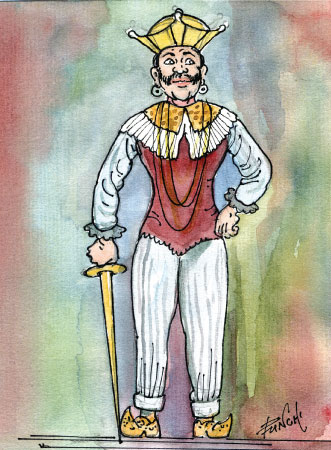|
Sri Lankan history:
King Rajasinghe I
by Husna Inayathullah
King Rajasinghe I ruled the Kingdom of Sitawaka. He is known for his
extreme bravery and patriotism. Born as Tikiri Bandara to King Mayadunna
of the Kingdom of Sitawaka, the name "Rajasingha" was given to him after
a fierce battle against the Portuguese Forces. Rajasinha means the King
of Lions.
According to historical records he reigned from 1581 to 1592.
However, according to De Queros, Mayadunne handed over the kingdom to
Rajasingha in 1578. In 1581,Mayadunne died leaving Rajasingha to ascend
the throne.

While King Rajasingha's main battle was against the Portuguese forces
in defence of the sovereignty of the Sinhala monarch, he had to battle
with numerous internal forces. Some regional leaders supported directly
and indirectly by forces from Portugal.
One such adventure of Tikiri Bandara was the battle against his
brother-in-law Veediye Bandara. Mayadunne initiated the campaign to
destroy Veediye Bandara primarily due to the ill treatment meted out to
Mayadunne's daughter Tikiri Kumari who was the wife of Veediye Bandara
and non-rendering of the support to Mayadunne to wage war against the
Kandyan ruler.
Combined Sitawaka and Portuguese troops attacked Veediye Bandara's
fort at Pelenda chasing him down to Devundara and capturing Tikiri
Kumari. Sitawaka troops were led by 12-year-old Tikiri Bandara.Veediye
Bandara re-grouped with the troops of the Kandyan leader and reached
Salpiti Korale to attack Sitawaka troops. He was defeated by Tikiri
Bandara again. He fled to Kanda Uda Rata and returned to Alut Nuwara
with troops of the Kandyan king.
After a fierce battle at Alutnuwara, Veediye Bandara was decisively
defeated by Tikiri Bandara.
According to the "Alakeshwara War", this battle was so fierce and
legendary, following which Tikiri Bandara was called "Rajasingha." The
Rajawaliya states that the title Rajasingha that implies " Lion who is
the king of kings" was given to him following this famous battle.
While Rajasingha waged his war against the Portuguese, King
Karaliyadde Bandara, utilised Portuguese soldiers to protect his Kandyan
kingdom.Infuriated by this relationship with Portuguese invaders, with
the support of Weerasundera Mudali of Peradeniya, Rajasingha led his
troops up to the entry point at Balana in 1583 and chased Karalyadde
Bandara.
The battle with the Portuguese in Mulleriyawa was the bloodiest
fought to date. While the Portuguese held guns and more advanced
weapons, the Sinhalese army simply equipped with swords and their
ancient fighting method called Angam Pora and defeated the entire
Portuguese army. This was the greatest defeat a European army ever had
in an Asian land.
King Rajasinghe I appointed a South Indian, named Aritta Kivendu as
his chief advisor and acted on his advice. He was awarded the title
Mannamperuma Mohottala. King Rajasinha arranged the marriage of
Mannamperuma Mohottala to a sister of a junior queen known as "iron
daughter". He converted to Hinduism. He was reported to have settled
Brahmans at significant Buddhist sites such as Sigiriya and Sri Pada.
Under the advice of Mannamperuma Mohottala, he razed many Buddhist
religious sites to the ground. The discontent caused among Buddhist
public and prelates was a major reason for the downfall of the kingdom.
The annexation of the Kandyan kingdom and killing many royals also
believed to have contributed to the decline. His cruel approach towards
Buddhism ignited anti-government rebellions with the involvement of
Buddhist prelates. This gave rise to his conflict situation with
Bhikkhus.
In the Sath Korale region, a prince named Pothupala Bandara rebelled
against Rajasingha with the support of the Portuguese.
The rebellion was suppressed and all leaders who supported it were be
headed. According to the Manadarampura Puwatha, prelates were involved
in an attempt to make Konappu Bandara the king of Kandy.
This conspiracy was exposed leading to the execution of hundreds of
Buddhist prelates. Mandaram pura puwatha reported that in one place,121
bhikkhus were killed by Rajasinha.
One of the notable victims was the chief prelate of Sitawaka. Support
of the Maha Sangha that was a pillar of strength for Mayadunne and
Tikiri Bandara to mobilise the public support for the sitawaka kingdom
rapidly eroded.
Konappu Bandara having returned to Kandy through Mannar started a
rebellion in Kandy. First he defeated the troops led by general and
Aritta Kiwnendu. Secondly, Konappu Bandara defeated troops led by King
Rajasingha himself. Rajawaliya reported that he withdrew saying that
there was no king in front of him who fought valiantly from 11years of
age.
However, this person who waged war in Kandy has lots of merits. On
his return from the defeat at Balana,he died in March 1592.
The reason for his death was a wound caused by a pointed bamboo
segment at Pethangoda while returning to Sitawaka. Rajawaliya further
recorded that the death was a result of the curse imposed on him by the
Dodampe Ganithaya. He was cremated at Mahanuwara the then capital
Sitawaka. |

